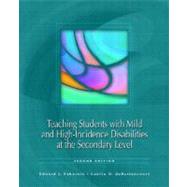
| Special Education and Adolescence | |
| Introduction to Adolescents with High-Incidence Disabilities | |
| Adolescence and its Characteristics | |
| Secondary Level Students with High-Incidence Disabilities | |
| Instruction Methods | |
| Effective Instruction and Behavior Management Techniques | |
| Reading Instruction for Adolescents with High-Incidence Disabilities | |
| Written Language Instruction for Adolescents with High-Incidence Disabilities | |
| Teaching Mathematics to Adolescents with High-Incidence Disabilities | |
| Cognitive Strategy Training and Study Skills Instruction for Adolescents with High-Incidence Disabilities | |
| Social Skills Instruction | |
| Current and Future Instructional Issues | |
| Content Area Instruction for Adolescents with High-Incidence Disabilities | |
| Transition-Related Instruction | |
| Education of Adolescents with High-Incidence Disabilities in Post-secondary Programs | |
| Appendix | |
| Name Index | |
| Subject Index | |
| Table of Contents provided by Publisher. All Rights Reserved. |
The New copy of this book will include any supplemental materials advertised. Please check the title of the book to determine if it should include any access cards, study guides, lab manuals, CDs, etc.
The Used, Rental and eBook copies of this book are not guaranteed to include any supplemental materials. Typically, only the book itself is included. This is true even if the title states it includes any access cards, study guides, lab manuals, CDs, etc.